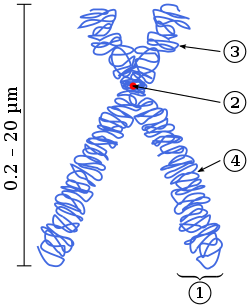Chromosome

(1) Chromatid – one of the two parts of the chromosome after duplication.
(2) Centromere – the point where the two chromatids touch.
(3) Short arm. (4) Long arm.

The chromosomes of a cell are in the cell nucleus. They carry the genetic information. Chromosomes are made up of DNA and protein combined as chromatin. Each chromosome contains many genes. Chromosomes come in pairs: one set from the mother; the other set from the father. Cytologists label chromosomes with numbers.[1]
Chromosomes are present in every cell nucleus with very few and special exceptions. This means they are found in all eukaryotes, since only eukaryotes have cell nuclei. When eukaryote cells divide, the chromosomes also divide.
When a somatic (body) cell (such as a muscle cell) divides, the process is called mitosis. Before mitosis, the cell copies all the chromosomes and then it can divide. When they duplicate, chromosomes look like the letter "X". When they are doubled, the two halves are called chromatids (see diagram). The chromatids are joined at the centromere.
There are 46 chromosomes in a human as 23 pairs. Everyone has a set of chromosomes from their father and a set from their mother. They include a pair of sex chromosomes. The mother's eggs always contain an X chromosome, while the father's sperm contains either a Y chromosome or an X chromosome. That determines the sex of the child. If the child gets a Y chromosome from the father it is male. If it gets an X from the father, it is female.
To produce sex cells (gametes), the stem cells go through a different division process called meiosis. This reduces the 23 pairs (diploid) to 23 singles (haploid). These, when combined by fertilisation, produce the new set of 23 pairs.
Different animals have different numbers of chromosomes. If a person does not have the usual number of chromosomes, they may die or have one or more peculiarities. For example, they might get a genetic disorder like Down syndrome (extra chromosome 21), or Klinefelter syndrome (a male with two X chromosomes). Some genetic disorders are more common than others.
Polytene chromosomes
Polytene chromosomes are over-sized chromosomes which have developed from standard chromosomes. Specialized cells undergo repeated rounds of DNA replication without cell division (endomitosis). Polytene chromosomes form when multiple rounds of replication produce many sister chromatids that are stuck together in parallel.[2]
Polytene chromosomes are found in Drosophila species and in nonbiting midges. They also occur in arthropods of the class Collembola, ciliate protozoa, early stages of mammalian embryos, and suspensor cells in plants.[3]
Polytene cells have a metabolic function. Multiple copies of genes allows a high level of gene expression. In Drosophila, for example, the chromosomes of the larval salivary glands have many rounds of endoreduplication.
Chromosome puffs (seen in diagram) are diffused uncoiled regions of the polytene chromosome. They are sites of active transcription.
Chromosome Media
The major structures in DNA compaction: DNA, the nucleosome, the 10 nm "beads-on-a-string" fibre, the 30 nm fibre and the metaphase chromosome
Human chromosomes during metaphase
Related pages
References
- ↑ White M.J.D. 1973. The chromosomes, 6th ed. London: Chapman and Hall
- ↑ Zhimulev, Igor F. & Koryakov, Dmitry E. 2009. Polytene chromosomes. Encyclopedia of Life Sciences (eLS). Chichester: Wiley. pp. 1–10. [1]
- ↑ Sumner, Adrian T. (2002). Chromosomes: organization and function. Chichester: John Wiley & Sons. pp. 182–193. ISBN 9780470695227.








